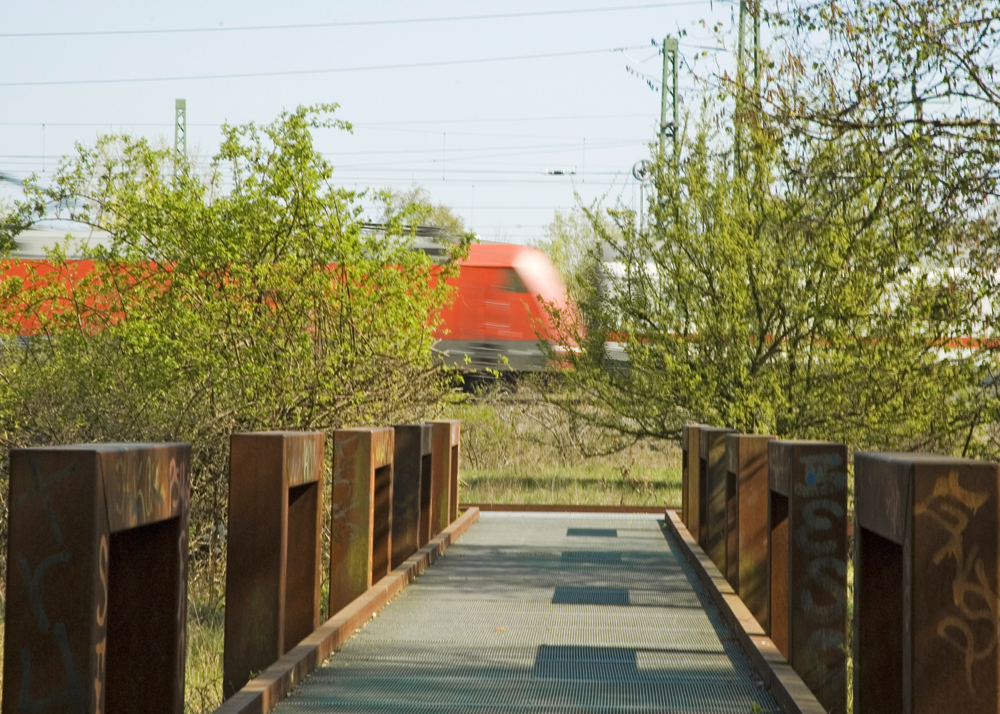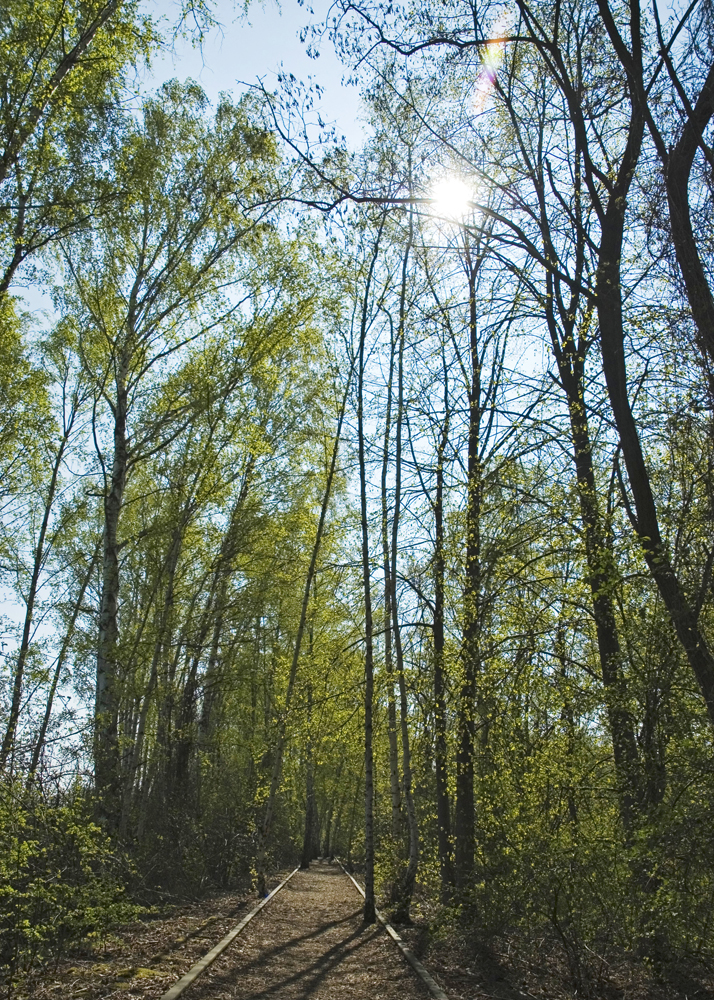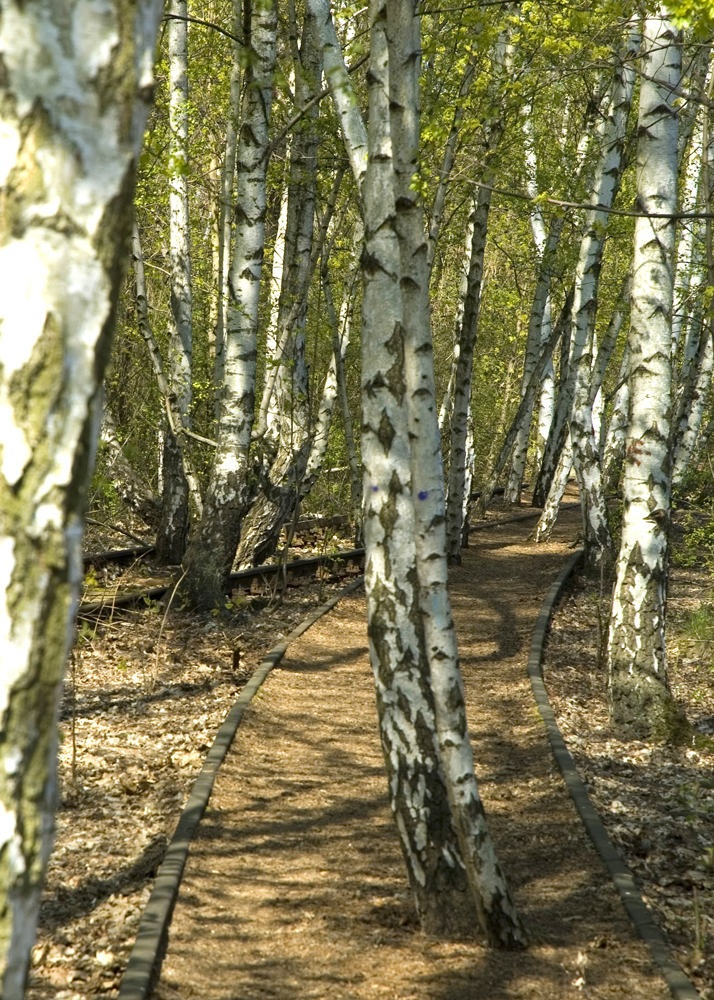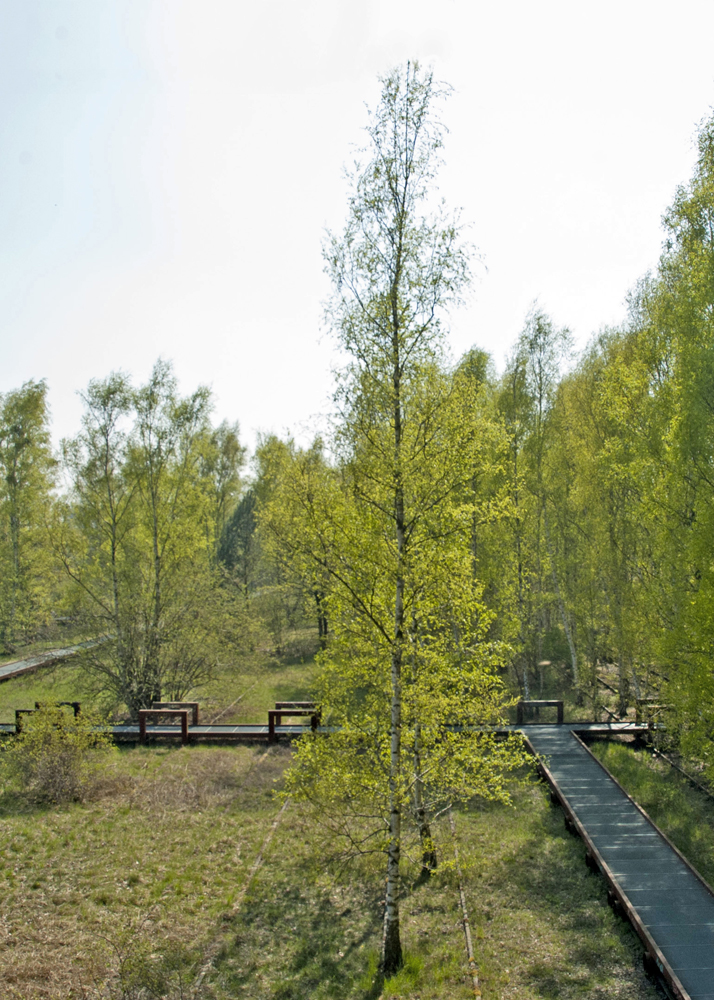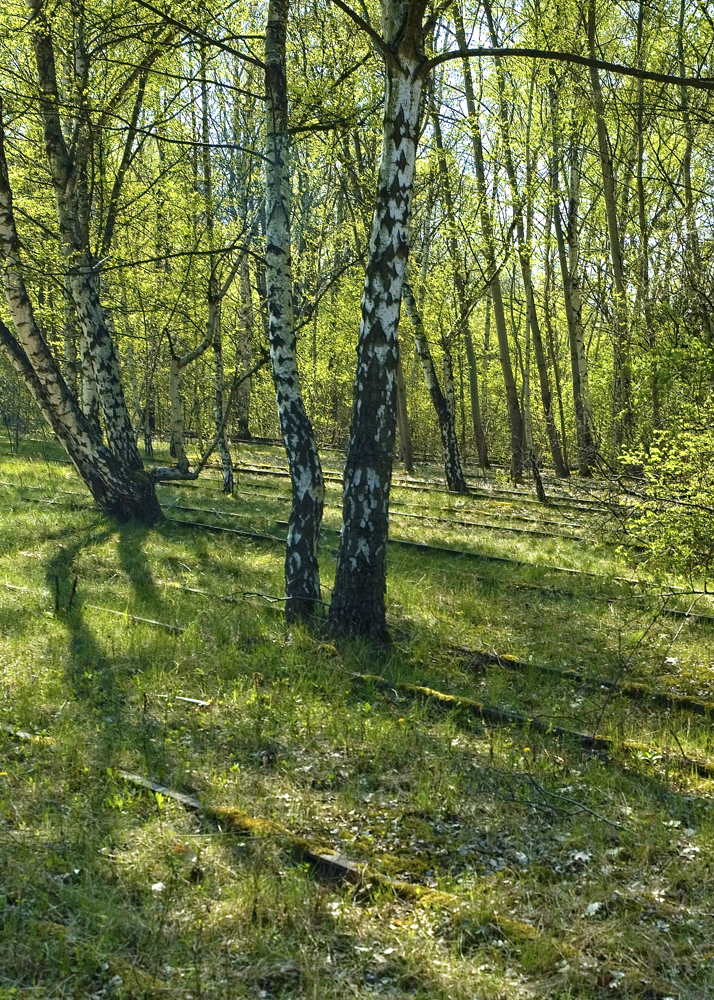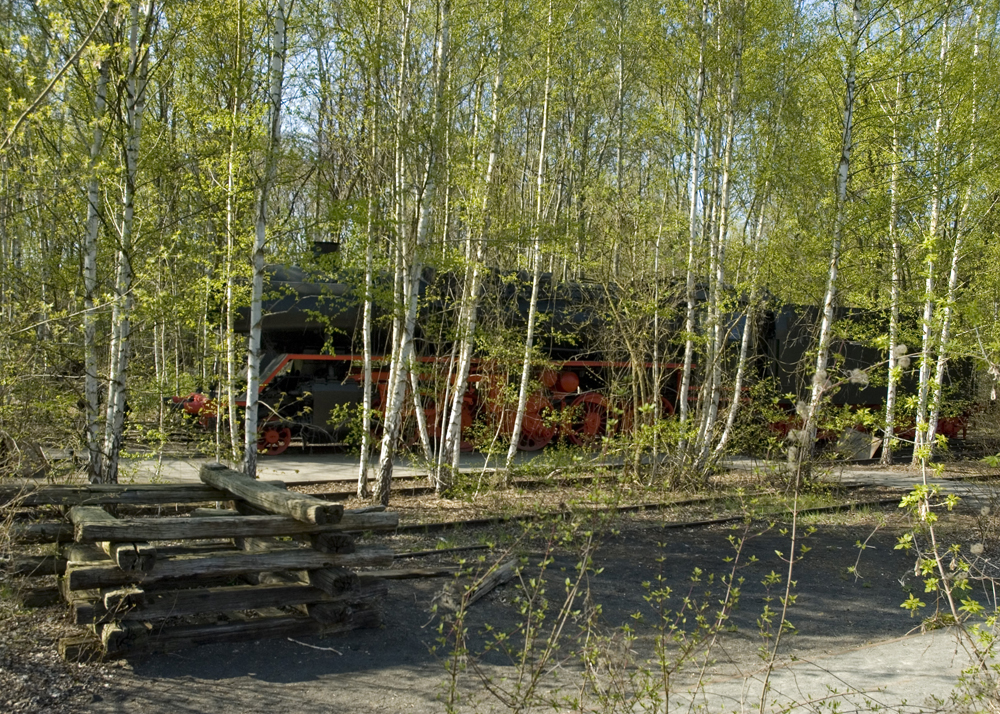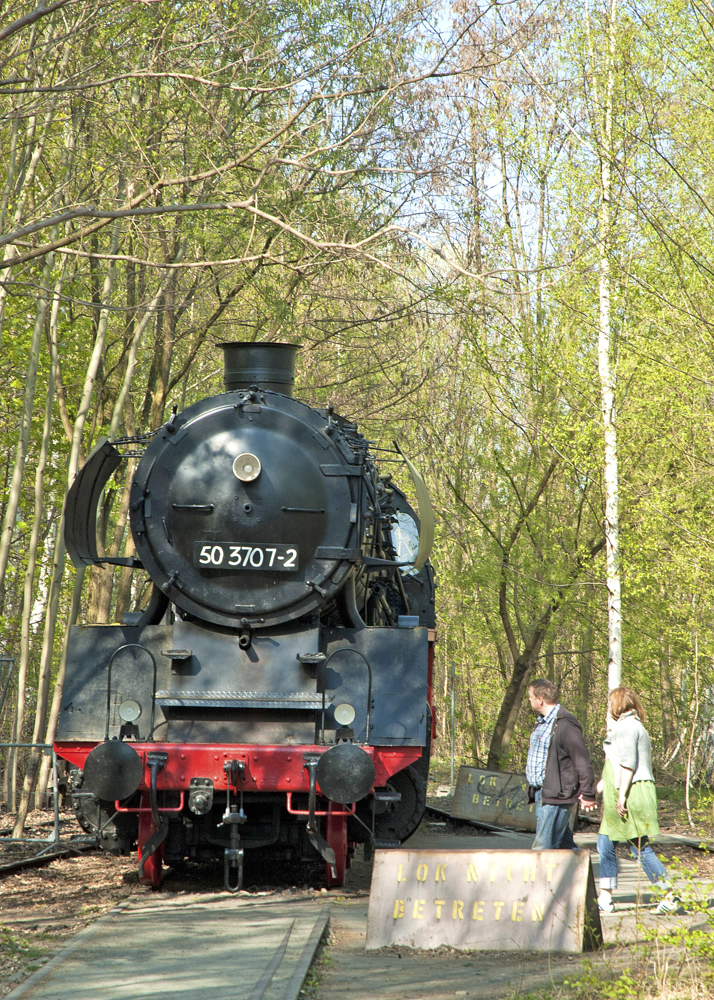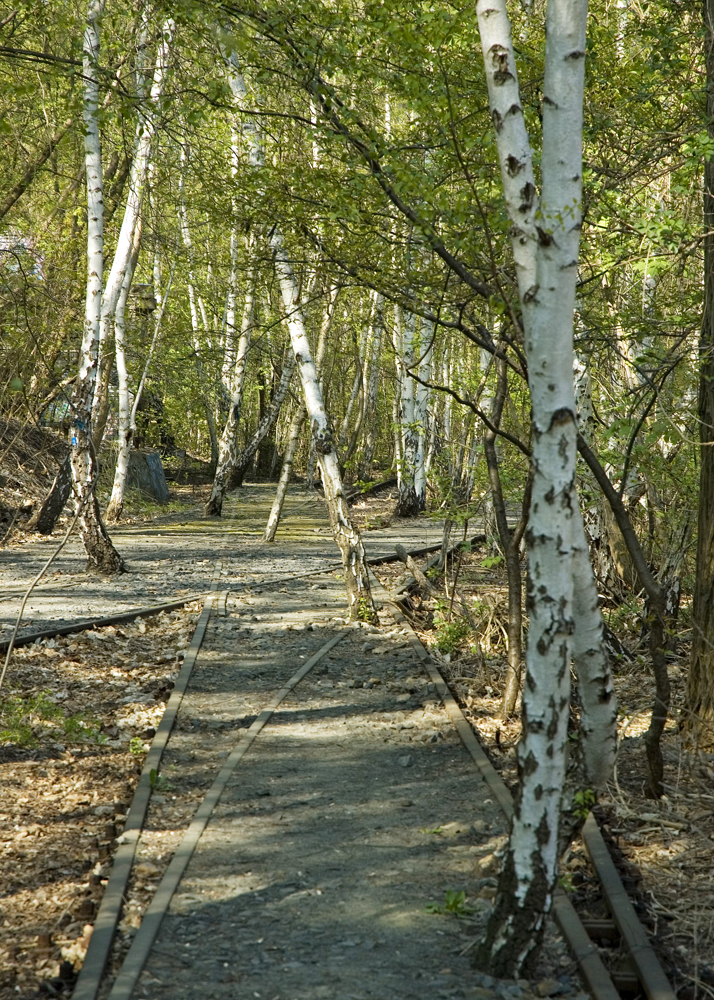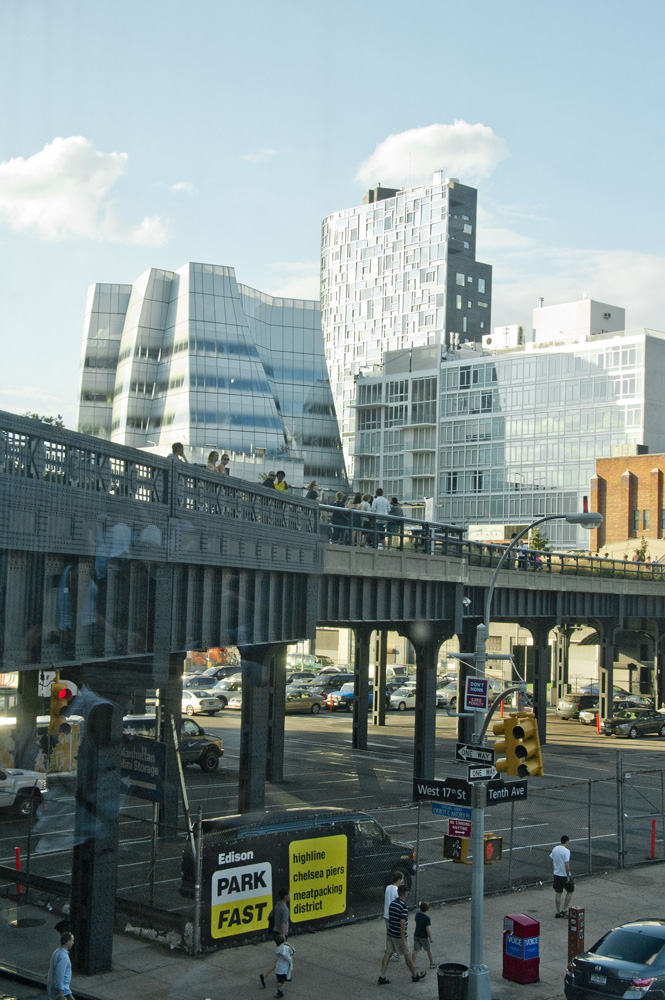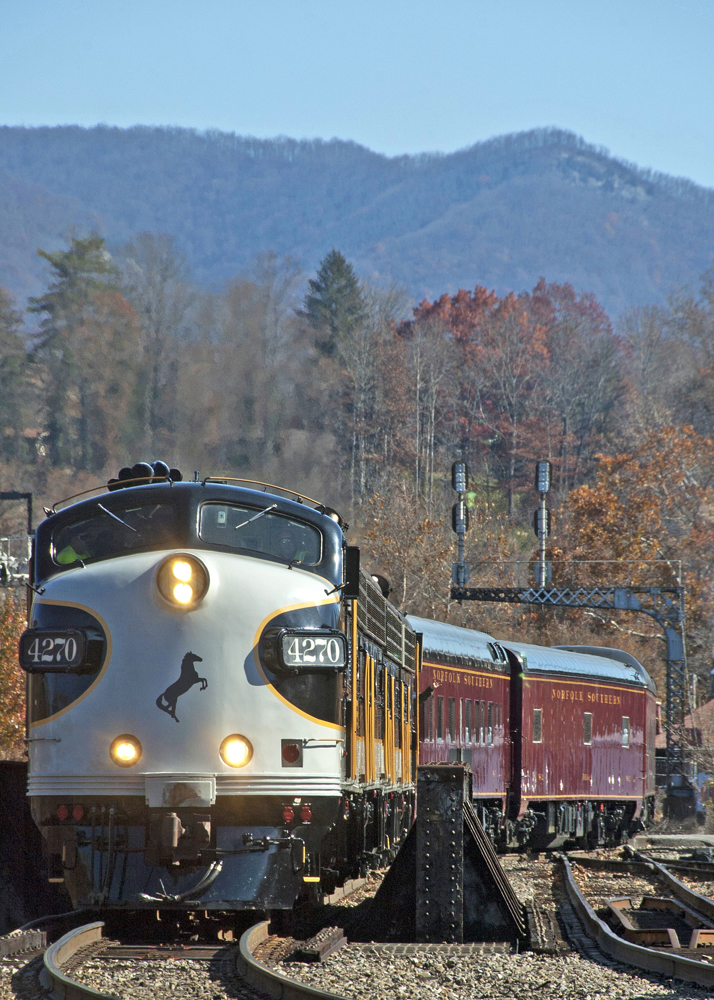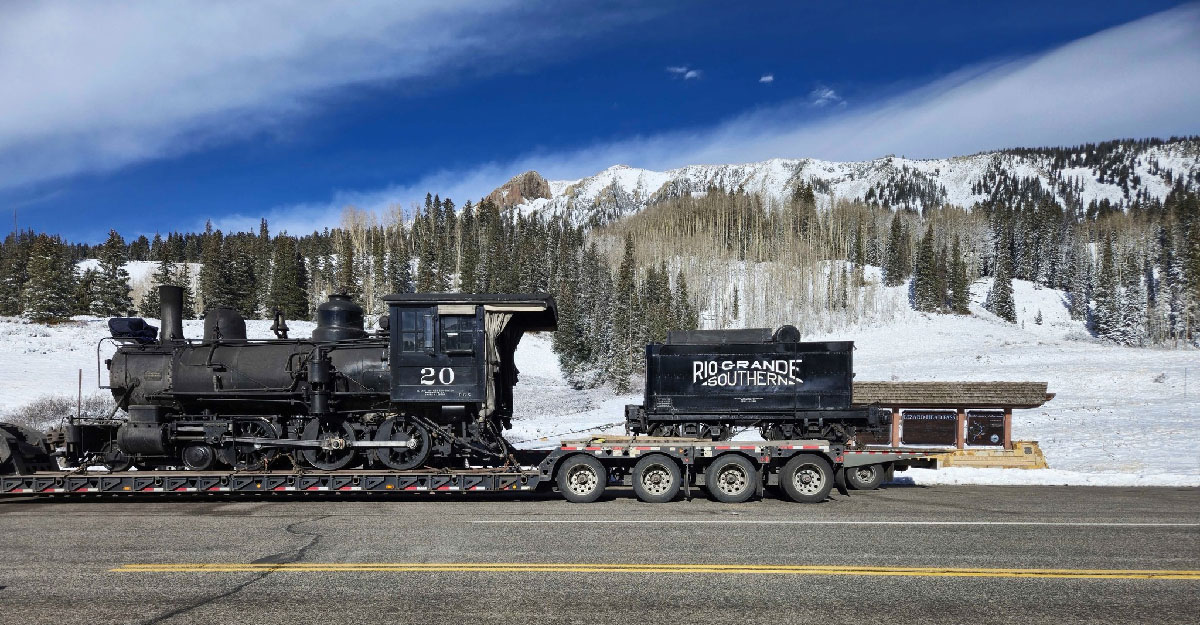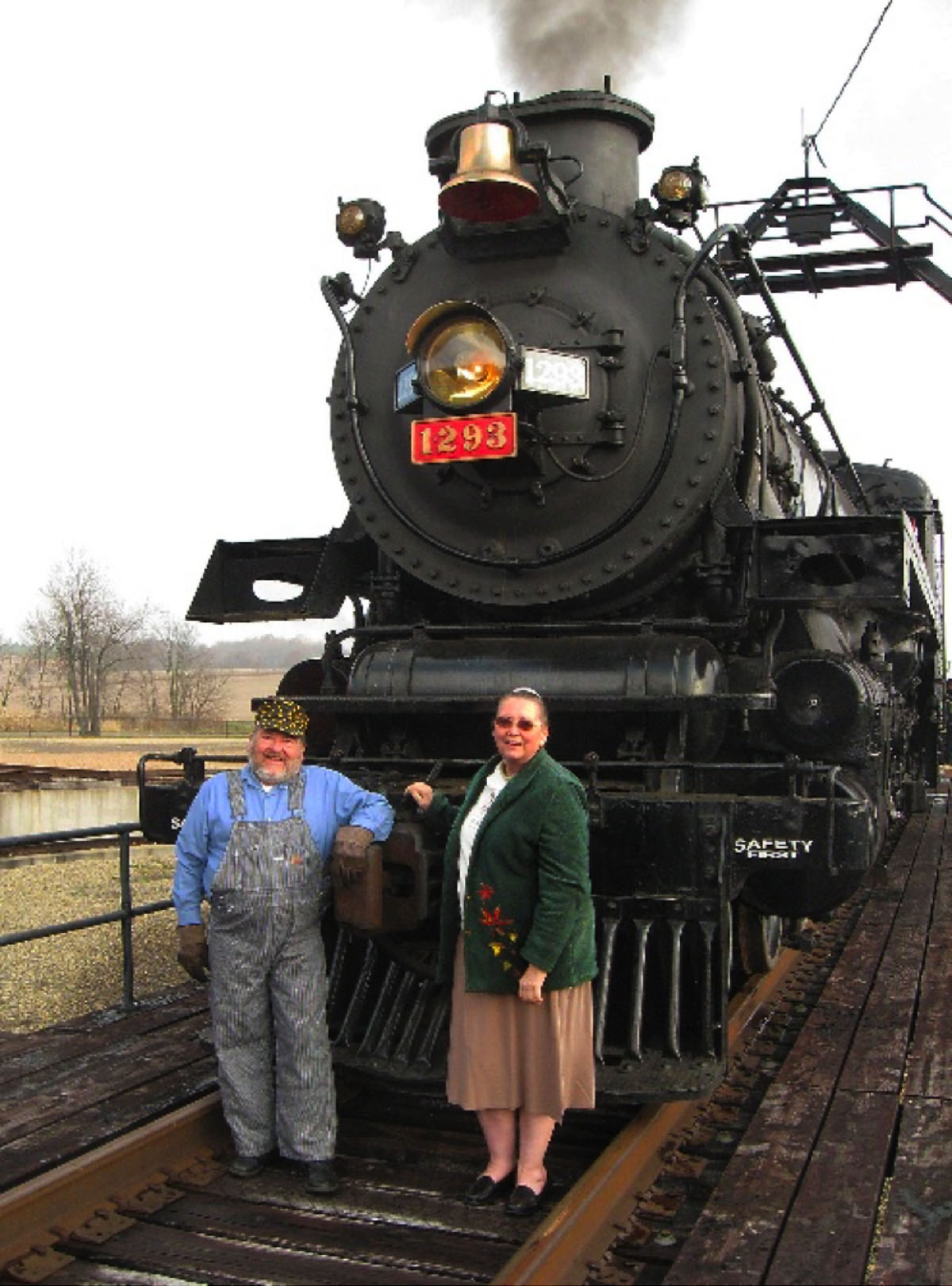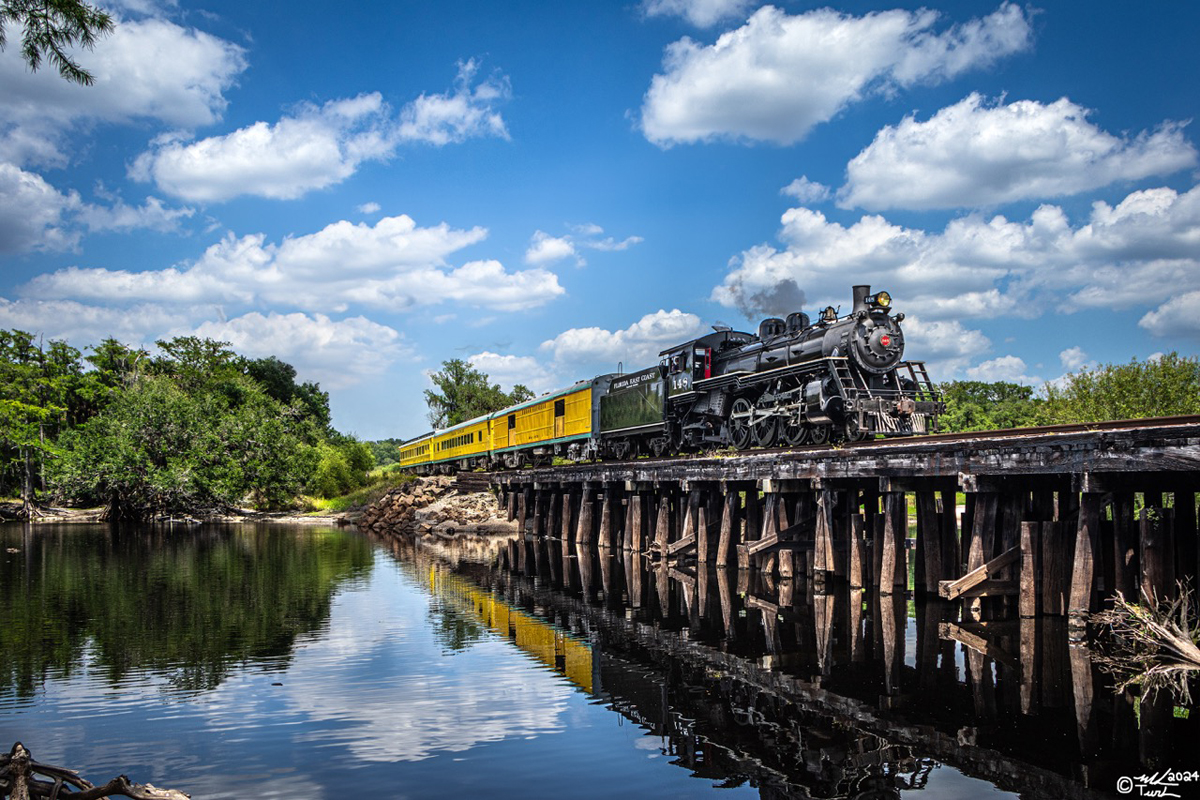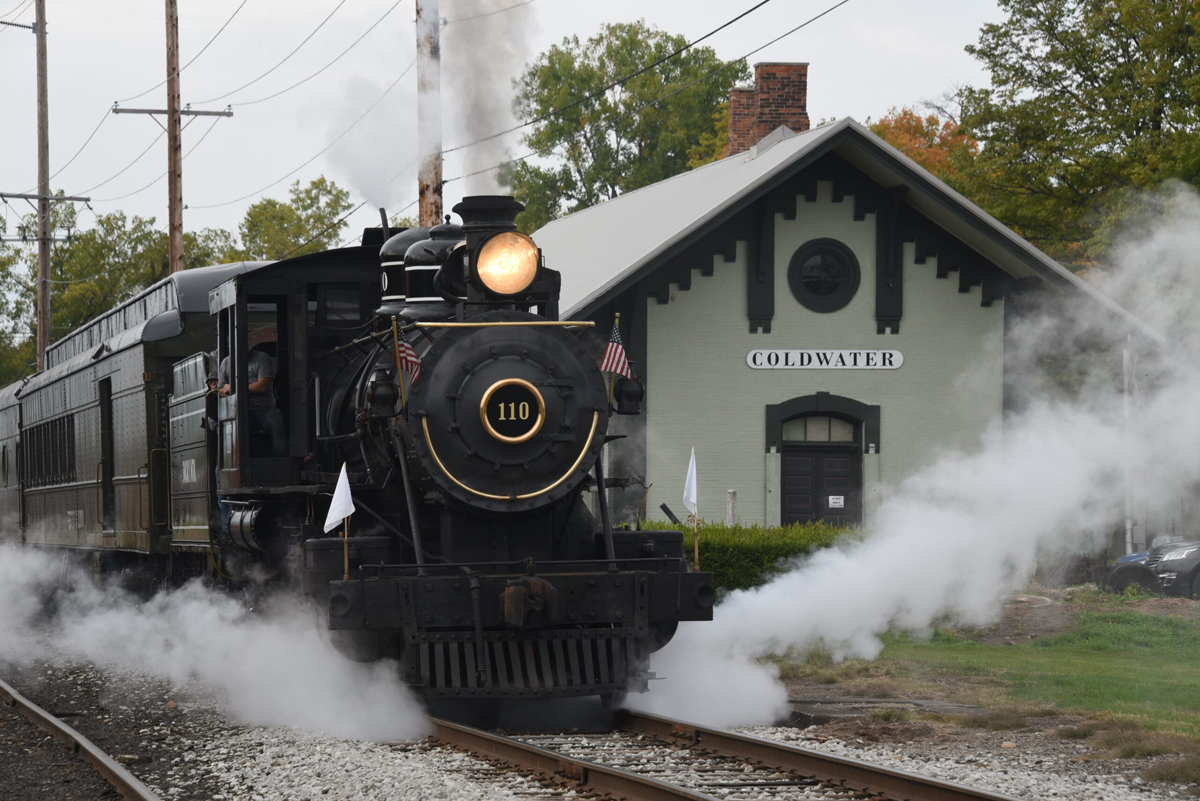A Deutsche Bahn intercity train whizzes past a steel boardwalk in Natur-Park Südgelände.
Many in the U.S. railroad preservation movement adhere to this mind-set: acquire equipment and artifacts, operate what is economically advisable, and/or plinth whatever is not in service — sometimes without cover or maintenance, resulting in a historically accurate mid-century scrap pile.
In the past decade, however, there has been a rise in hybrid preservation models, allowing artifacts that might otherwise be destroyed to maintain an important place in the community or industry, sometimes even a larger role than their original one.
Post-decay preservation
There is something enticing about running across lost relics of the past buried beneath the underbrush and dirt, whether the foundation of an original settler’s home or the growth of oak trees between the ties of an abandoned rail yard. In the 1990s, a citizens group on the southwest side of Berlin undertook an effort to capture that spirit and preserve it in place.
The yard’s history reaches back to 1841, and the Deutsche Reichsbahn built a large classification and locomotive maintenance facility in the 1930s to serve as a major support yard to the now abandoned (and destroyed) Anhalter Bahnhof. Through the war, the rail yard suffered much of the same damage that the rest of the city fared. Although the yard was rebuilt, it only remained in service until 1952.
In West Berlin, following the construction of the Berlin Wall, the rail yard sat unused for decades, a 44-acre slice of land that, despite the presence of ties and steel, could not hold back the encroachment of nature. By the time the Berlin Wall fell and modern-day Deutsche Bahn, AG became interested in repurposing the land, it had become a cherished natural asset to the largest city in Germany. As plans were announced to develop the rail yard once again, a local organization known as “Green Berlin” was incorporated to transform the wild rail yard into a well-maintained nature preserve. With funding made available by the Allianz Ecological Foundation in 1995, the group committed DM 1.8 million ($1.1 million) to convert the abandoned rail yard into Natur-Park Südgelände.
By the year 2000, the renovated park opened. With mulch filled to the railheads on certain paths, and steel boardwalks built over larger, swampier sections, the Natur-Park Südgelände is an incredible natural resource to the residents of Berlin. Though much of the rail infrastructure remains in place, including a large water tower, multiple water cranes, an operable turntable, a backshop building, and a 50-class steam locomotive (a precursor to the better-known class 52 “Kriegslok”), they are kept dormant, casting shadows of the industrial past upon the natural sanctuary and cultural center of today.
A home to many art installations, concerts, and graphic representations, Natur-Park Südgelände today serves a more interconnected role in the community than it would as a preserved rail yard. It is a unique hybrid between historic preservation (all of the infrastructure remains) and nature preserve.
Preservation in form, not function
When CSX ceased operation on the former New York Central “West Side Line,” an elevated rail corridor through the Lower West Side of Manhattan, it was again citizen activists, this time a few local New Yorkers, who saw to saving the railroad infrastructure. Backed with $50 million from the City of New York, the Friends of the High Line worked diligently with CSX to acquire and completely redevelop the elevated railway into a linear, urban park, complete with wildflower planters, expansive landscaping, and select remnants of track and signal infrastructure.
Today, the “High Line” is a vibrant urban green space, bringing with it an influx of tourists and New Yorkers to the former industrial district. Like Natur-Park Südgelände, the High Line provides a new and unique natural presence in the largest city in its country. For better or worse, however, the corridor is driving gentrification of the area and little of the railroad infrastructure (in terms of ties, rail, and other track material) remains in place.
What is certain, though, is that the once-abandoned rail corridor, which faced an uncertain future in light of ever-rising scrap steel prices, can remain a shadow of its serpentine self, affording visitors the opportunity to cut through buildings and explore the city from above, even hosting an amphitheater to watch the traffic below. This is adaptive preservation in form not function, wherein abandoned, forlorn rail infrastructure can be preserved for a completely different purpose. Though altered, the main presence of the line remains, and now millions more people interact with it directly than had it been preserved as an elevated freight rail line.
Preservation through adaptation
In the category of “the worst thing to do to a piece of equipment is run it,” having an active, vintage locomotive and trainset is something unparalleled by static display, but it does take a toll on the artifacts. When maintenance and reliability become an issue, the utility of operating the equipment begins to wane.
Consider the sets of 1950s diesels running on the Union Pacific (E-units) and Norfolk Southern (F-units) rail lines. Both received significant internal upgrades, including modern prime movers and traction motors, to continue hauling the railroads’ executive passenger rail fleets. In both cases, the locomotives have essentially been converted into modern road switchers, complete with 645 prime movers, modern control cabinets, and upgraded traction motors. They still look and (kind of) sound like the locomotives they were when built, but they are able to roll on reliably over millions of miles, proudly representing each railroad’s heritage — and dedication to preserving it.
Of course, some purists might prefer to see the engines run with their original nose doors and 567 prime movers, but to the millions of people in the thousands of communities lining the main lines, having an out-of-the-ordinary executive passenger train, complete with matching passenger diesels, is a greater benefit. In particular on the NS, having dedicated power for executive trains frees up all available road freight locomotives for freight service — while the vintage ambassadors represent thoroughbred history with 1950s class.
Alternatives are keys to the future
As preserved rail equipment from “the golden age” continues to grow older, it is important that railway preservationists be open and accepting of more than the status quo.
Just think: It is impossible to envision a wooden passenger coach from 1906 on an Amtrak excursion today, but the all-steel Pullman from 1912 is right at home on special trains. As the difference between those ages and technologies continue to diverge from today’s railroading, a more flexible approach to preservation can allow more people to experience more elements of railroading’s past. Look around at your local communities, see what railroad resources are present, and do not hesitate to propose alternative solutions in the face of sometimes daunting challenges. The history of our future depends on it.
DAVIDSON WARD is a railroad consultant with R.L. Banks & Associates, Inc. and President of the Coalition for Sustainable Rail. He is also a member of the Center for Railroad Photography & Art. This is his second Web exclusive for Trains.





